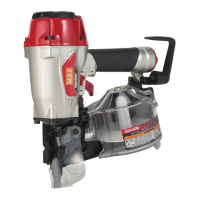
Do you have a question about the Max CN565S and is the answer not in the manual?
| Model | CN565S |
|---|---|
| Category | Power Tool |
| Type | Coil Nailer |
| Operating Pressure | 70-120 psi |
| Wire Weld Collation | Yes |
| Magazine Capacity | 300 nails |
Emphasizes wearing eye protection to prevent injury from dust or flying fasteners.
Advises on hearing protection in high noise environments to prevent damage.
Mandates using only an air compressor, not other gases, to prevent explosion risk.
Specifies operating pressure range (70-100 psi) and maximum limit (120 psi).
Warns against operating near flammable substances due to explosion risk.
Stresses using correct fittings to prevent accidental firing after air disconnection.
Requires disconnecting air and emptying magazine for safety during downtime or maintenance.
Recommends checking screw tightness before operation to prevent accidents and tool damage.
Advises against touching the trigger unless intended to drive a fastener.
Instructs not to point the discharge outlet at people to prevent serious accidents from misfiring.
Stresses using only specified fasteners to ensure proper tool function and prevent malfunction.
Warns about proper placement to prevent fasteners from flying up dangerously.
Directs users to keep hands and body clear of the fastener discharge area to avoid injury.
Advises against fastening near edges or thin material to prevent splitting and flying fasteners.
Warns against driving fasteners on top of others to prevent deflection and injury.
Requires removing all fasteners from the magazine after use to prevent accidents.
Advises frequent checks of the contact trip mechanism for proper function.
Provides guidance for safe fastening on slanted or elevated surfaces.
Prohibits using the tool if controls are disconnected, altered, or not working properly.
Warns against actuating the tool into free space to prevent hazards from flying fasteners.
Reminds users to always assume the tool contains fasteners for safety.
Encourages treating the tool as a serious working implement.
Prohibits playful or unsafe behavior with the tool.
Prevents loading fasteners when operating controls are activated.
Identifies and illustrates the main components of the pneumatic coil nailer.
Details key specifications like height, width, weight, operating pressure, and air consumption for each model.
Lists nail length, shank diameter, shank type, and head diameter for compatible fasteners.
Provides noise and vibration level measurements for the tool.
Outlines general construction uses for which the tool is suitable, like siding and sheathing.
Details requirements for air compressor, hoses, and fittings for safe and efficient operation.
Explains the function and importance of a 3-piece airset (filter, regulator, oiler) for tool performance.
Lists essential checks and steps to perform before starting nailer operation.
Reinforces safety measures and handling procedures during active tool use.
Provides step-by-step instructions on how to load nails into the magazine correctly.
Guides users through testing the tool's firing mechanism after setup.
Explains how to operate the tool using the contact trip mechanism for continuous firing.
Details the procedure for firing one nail at a time using the anti-double fire mechanism.
Helps identify tool models by trigger color and their operating mechanisms.
Describes how to adjust the nail driving depth for different materials and fasteners.
Explains how to adjust the exhaust cover to direct air away from the operator.
Details the function and use of the trigger lock for safety.
Describes the process of removing the plastic sheet from driven nails.
Advises on attaching and using the contact tip for soft materials.
Provides essential tips for maintaining tool performance and longevity.
Outlines daily checks and maintenance tasks to perform before operation.
Gives instructions on proper storage conditions to protect the tool from damage.
States that troubleshooting and repairs should only be performed by authorized distributors or specialists.
Lists specific applications and environments where the tool should not be used according to regulations.
